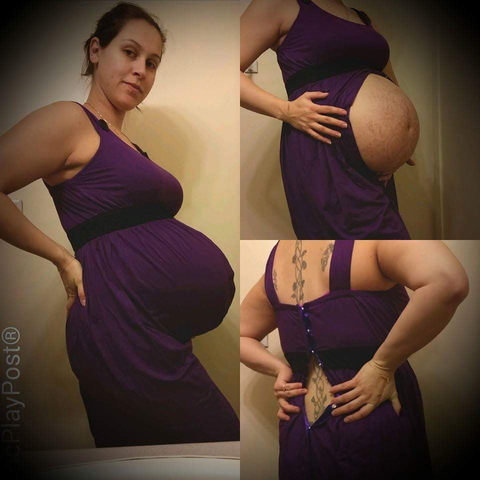Becoming a surrogate cost Shannon her fertility and threatened her life, but she doesn’t regret her decision to carry someone else’s child. In fact, she calls it one of the happiest times in her life. This is her story.
Shannon gave birth to her first daughter at just 19. She had just finished an amazing pregnancy where she was jogging, biking and running without a hint of morning sickness with a traumatic birth that included an episiotomy, two and a half hours of pushing and a baby that came out struggling to breathe.
Despite suffering a traumatic labour, Shannon wanted to fulfill her dream of becoming a surrogate.
“I loved being pregnant,” she said.
Shannon said that she didn’t realize at the time that her birth was traumatic, likely due to her age and inexperience. After the birth, she suffered an epidural migraine and was unable to sit up for two weeks. Her baby also suffered from colic. Rather than turn her off the idea of surrogacy, she became more resolved.
“Babies weren’t for me, but pregnancies were.”
While Shannon loved her daughter, she was not in a rush to have more of her own. Her husband at the time was not on board with her plans to help another couple become a family, and the two eventually went their separate ways. When she met her current husband she made sure he was on board for all of her future plans.
“When I met my husband I said: I want to be a surrogate. I want more kids, and I want a dog. These are all things you better be okay with,” she said. “He was.”
Expanding the family
Shannon went on to have two more daughters back to back, with fairly easy pregnancies and labours. She had suffered several miscarriages throughout the years and after her final loss, she decided to stop at three children, but perhaps it was time to become a surrogate.
“I wasn’t done being pregnant because I loved being pregnant.”
Her husband was worried about the realities of surrogacy. He couldn’t understand why she would put her body through so much stress for somebody else.
“At that point, it wasn’t for somebody else, it was for me,” she said. “I wanted to be pregnant.”
A new journey
With the support of her husband and extended family, Shannon signed up with a surrogacy agency in March and was matched with a couple in April.
Sometimes surrogates already know the couple they will carry a child for, for example, they may be family members or close friends. Surrogates who wish to help a stranger can sign up with an agency where they can be matched, similar to a dating site.
“Parents can see your profile, see where you live and your children and they decide if they want to pick you,” says Shannon. “You can say yes or no. You are in control.”
Shannon set some clear parameters for the couple she wanted to help. She wanted the couple to live close enough that they could attend every doctor’s appointment, have no children, and be involved in her pregnancy.
Meeting the perfect couple
When a couple contacted her that ticked off all of her surrogate boxes, they decided to meet up at the Science Center for a ‘date’ with her husband and kids.
“We talked about what our expectations were. I was very straightforward and down to the nitty-gritty questions because I didn’t want to waste her time and I didn’t want her to waste my time.”
They made sure they were on board for the tough stuff, such as their stance on selective reductions and abortions, to avoid any conflicts down the road.
“It was a very easy going but an informative first meeting.”
Shannon and her husband had to get bloodwork done at a fertility clinic and a three-hour psychological evaluation.
“It’s to make sure that you know what you are getting into and you are not doing it for the wrong reasons. You need to have support at home as well because you need support in order to be a surrogate.”
Womb for sale?
Surrogate mothers in Canada are not paid for their services but can be reimbursed for out of pocket expenses by their IPs (intended parents). In Shannon’s case, she had to travel to the fertility clinic and hire a babysitter, so she was reimbursed for those expenses. She also had items like maternity clothes paid for as well.
Once Shannon was cleared to carry a baby, both parties had to sign a contract with a lawyer.
The contracts can be very specific.
“If they want you to eat a plant-based diet, they can put that in a contract. If they don’t want you to drink coffee, they can put that in a contract.”
Shannon said that her IPs were not rich.
“They were normal people who probably had to take a second mortgage for this,” she says. “In the end, it is probably $75,000 to $100,000.”
Protecting her family
Shannon scheduled her appointments so around her oldest daughter’s school schedule in order to keep an emotional distance.
“She knew I was pregnant and she knew it was for someone else,” she says. “She wasn’t really involved very much,” she says.
“I wanted to keep my family life and my surrogate life separate. I didn’t want to confuse any emotions.”
A natural approach
Shannon used a smaller fertility clinic that would allow for natural cycles where medications aren’t used and instead they follow the body’s natural cycle.
“A lot of bigger clinics don’t have time for that, so they give you medication to force your body to do what they want it to.”
Heartbreak
Shannon got pregnant on the first round of IVF in July. At her 13 week appointment, the same appointment when she was supposed to be released from the fertility clinic, she was told the baby had passed around 10 weeks.
“I have had so many miscarriages that never bothered me as much as that one,” she said. “Because it was somebody else’s and somebody’s dream. It was rough.”
Shannon had the option of pills or a Dilation and curettage (D&C), which is a brief surgical procedure to remove the contents of the uterus. She chose the pills because she hates needles, but ended up hemorrhaging at home. She had to spend the night at the hospital, had a retained placenta and then ended up with a D & C.
The experience strengthened her resolve to be a surrogate.
“I had to prove that I was going to give them this baby,” she says. “The miscarriage was more of a push to do it than a step back.”
Starting again
The hemorrhage caused the lining of her uterus to stop thickening. She went to the clinic about 50 times over the next five months to check if her body was ready for another cycle. By early spring they were ready to start again. The first IVF did not work but she finally got pregnant in April.
Shannon was so worried about miscarriage that she purchased a doppler to check the baby’s heartbeat.
“From nine weeks on I would check the heartbeat every day,” she says. “I needed to know that heartbeat was strong.”
The clinic also offered ultrasounds every two weeks for the first trimester to make sure the baby was progressing.
Shannon was not worried about becoming attached to the baby.
“I knew from the get-go that it wasn’t mine,” she said. “I would not want to keep somebody else’s child. I had three of my own running amok…I still had two in diapers and late night feeds. I didn’t need and I didn’t want another one.”
Shannon said while the pregnancy was similar to her other children’s and she enjoyed the extra attention that came from being a surrogate.
“The stores would ask when I was due and I would say it wasn’t mine,” she says. “Then the questions would come!”
The big show
By the end of the pregnancy, Shannon was really excited about the birth.
“I was excited to get to that stage and finally have the baby in their arms so I didn’t have that worry,” she says. “It’s kind of a lot more worry than your own because it is somebody else’s.”
Shannon ended up having another quick birth and even though she was very worried that her IPs would miss it, they were part of a team to support her through the birth, which included a doula, her husband, and a photographer.
“I wanted a team because I knew the parents would be taking the baby and I wanted people there who could hang out with me,” she says.
“Instead of me bonding with the baby, it was the parents bonding with the baby while I had conversations with other people. I didn’t want to be sitting in a room just watching them.”
The baby’s mom actually caught the baby after birth and the parents got to have skin to skin to bond with their new daughter. Within a few hours of entering the hospital, everyone was ready to go home.
“They were able to go home and have their first night at home. It was January 5th and it was snowing. It was perfect.”
Until it wasn’t.
The aftershock
In the days after the birth, Shannon got messages and pictures of the new baby and had lots of visits from friends. At three days postpartum she started having trouble breathing. She was sent to the hospital for tests, which indicated a possible blood clot. As she had just given birth the test wasn’t conclusive, the next day she got a CAT scan that shows she had a pulmonary embolism, which is a blood clot in your lung.
There are many possible causes of blood clots but it was believed Shannon’s was caused by hormones during her pregnancy.
One doctor had a theory that she could have experienced blood clots during this pregnancy and not her previous pregnancies because she was carrying a baby that was not genetically hers.
After her diagnosis, Shannon started to get anxiety over her health condition.
She was on blood thinners, which had to be injected in her stomach daily. For six weeks she was not able to be left alone because she could still get another blood clot and die. She had to once again get childcare for her children, but because this condition was considered to be a part of her postpartum care it was covered, including her $750 monthly shots which were needed for six months.
While her body eventually reabsorbed her blood clots, Shannon is not able to have any more children.
Shannon says her story is a happy one, but one that highlights the fact that anything can happen when you become a surrogate.
“Make sure you are done having a family because you can lose your fertility or possibly your life. There has never been a death in Canada from surrogacy, but I didn’t want to be the first.”
Looking back, she would do it all over again.
“It was one of the best times in my life because it was about me at that point,” she says. “I had somebody who wanted to talk to me because I was their star.”
If you are considering surrogacy you can check out Surrogacy in Canada Online for more information.
So what do you think PLNers? Would you consider surrogacy to help someone’s dreams of a family come true? Let us know in the comments!
*Opinions expressed are those of the author, and not necessarily those of Parent Life Network or their partners.






 Sponsored
Sponsored




